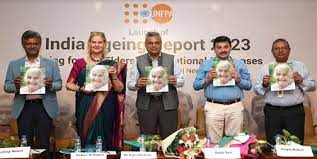
‘India Aging Report 2023’
‘India Aging Report 2023’
This topic is related to Current Affairs of IAS/PCS Prelims Exam and Main Exam General Studies Paper-3 Indian Economy.
September 28, 2023
In News:
- Recently, the United Nations Population Fund (UNFPA) has released the ‘India Aging Report 2023’.
- According to this report, the number of elderly people in India is increasing rapidly.
‘India Aging Report 2023’
Key points:
- According to the ‘India Aging Report 2023’, where the elderly population in India is increasing rapidly. At the same time, the number of persons under 15 years of age is declining.
- According to a new United Nations report, by the year 2046, the number of elderly people in India will exceed the number of children in the age group of 0-14.
- According to the ‘India Aging Report 2023’, there are 39 elderly people for every 100 children in India.
- According to the report, there has been a sharp increase in the elderly population in India since 2010.
- The number of people under 15 years of age in the country has shown a decline. It is currently the largest group of youth in the country.
- According to this report, not only India but the entire world's population is ageing.
- Talking globally, in 2022, out of a population of 7.9 billion, about 1.1 billion people were above 60 years of age. This is approximately 13.9 percent of the population. By 2050, the number of elderly people in the global population will increase to approximately 2.2 billion or 22 percent.
Possibility of 22.7 crore elderly population by 2036
- According to the 'India Aging Report 2023' of the United Nations Population Fund (UNFPA), today's relatively young India will become a rapidly aging society in the coming decades.
- The report states that in 2022 (as of July 1), there are 14.9 crore people aged 60 years and above, which is about 10.5% of the country's population. But by 2036 it is expected to increase to 15% (about 22.7 crores).
- By 2050, the share of older persons will be 20.8% (34.7 crore). Due to this, one out of every five people will become elderly.
More than 40 percent of the elderly in poverty:
- According to this report, more than 40 percent of the elderly in India are property poor. About 18.7 percent of the elderly do not have any means of earning income.
- Two out of every five elderly people in India are in the asset poor category. It is 4.2 percent in Jammu and Kashmir and five percent in Punjab while it is 40.2 percent in Lakshadweep and 47 percent in Chhattisgarh.
- This level of poverty among the elderly can affect their quality of life.
Uttar Pradesh second youngest state:
- There are 11 states with lower numbers of elderly people in the total population than the national average. Among these, Bihar is the youngest state in the country with 7.7% elderly population. Uttar Pradesh is the second youngest state with 8.1% elderly population. Among the top five states, Assam (8.2%) is at third place, Jharkhand (8.4%) is at fourth place and Rajasthan and Madhya Pradesh (8.5%) are at fifth place.
Kerala oldest state:
- Kerala is the oldest state with 16.5% population above 60 years of age. There has been an increase in survival of the elderly and a sharp decline in the fertility rate.
- Among the five oldest states, Tamil Nadu, Kerala and Andhra Pradesh are from the south, Himachal and Punjab are from the north. Andhra Pradesh (12.3%) is the fifth oldest state, Punjab (12.6%) is the fourth, Himachal (13.1%) is the third and Tamil Nadu (13.7%) is the second oldest state.
Causes for increasing number of elderly people in India:
- There are three reasons for the increase in the number of elderly people in India – decreasing fertility, decreasing mortality rate and increasing survival.
- Fertility in the country has declined by 20 percent in the last decade.
- The country's gross fertility rate was 86.1 during 2008-10, which has declined to 68.7 during 2018 to 2020.
- Government's efforts to care for the elderly:
- Under Article 41 of the Indian Constitution, state governments take measures to protect the rights of the elderly according to their economic capacity.
- In addition, the Government of India conducts policies and programs to address the problems related to population aging in accordance with the Madrid International Plan of Action on Aging (MIPAA), 2002.
About United Nations Population Fund (UNFPA):
- It is a subsidiary organ of the United Nations General Assembly.
- It was established as a trust fund by the United Nations Economic and Social Council (ECOSOC) in the year 1967.
- It is in operation since 1969.
- It was officially named United Nations Population Fund in the year 1987, but currently its short name UNFPA (United Nations Fund for Population Activities) is also in use.
- It also works to meet the Sustainable Development Goals on health (SDG3), education (SDG4) and gender equality (SDG5).
- Instead of support from the UN budget, it operates entirely on voluntary contributions from donor governments, intergovernmental organizations, the private sector, foundations and individuals.
mains exam question
According to UN report, the elderly population in India is increasing rapidly. Discuss.